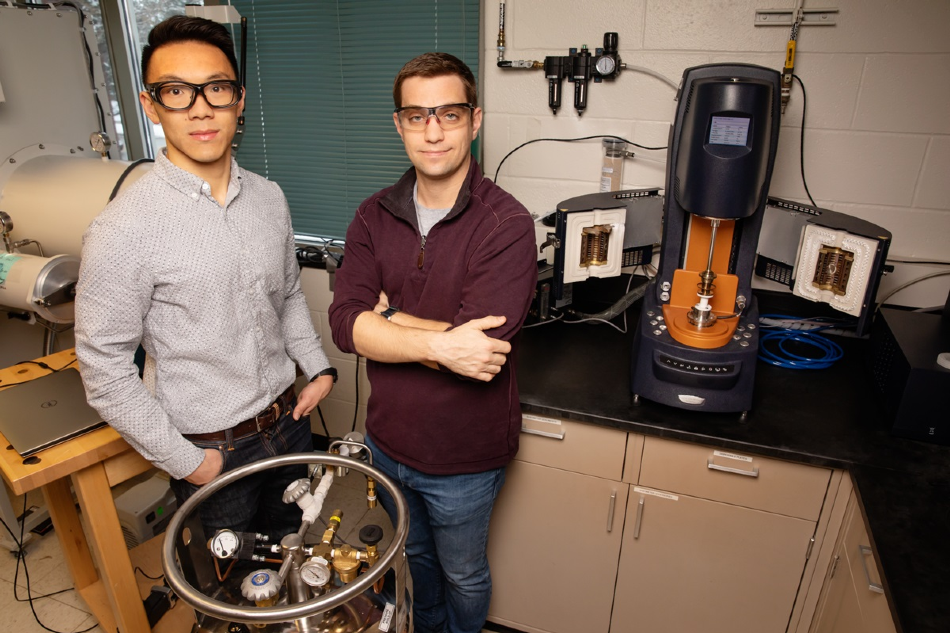
Image Credit: L. Brian Stauffer/ University of Illinois
Engineers at the University of Illinois have developed a new polymer-based electrolyte that enables batteries to be self-healing and recyclable. The researchers have been investigating the use of solid, ion-conducting polymers in order to overcome the limitations currently faced with liquid electrolytes.
Lithium-ion batteries are typically made with liquid electrolytes which are prone to defects that have been known to cause the batteries to ignite during a short-circuit. The defects – known as dendrites – are tiny tree-like structures that can grow inside a lithium battery and pierce the protective shell which accelerates battery failure. These flaws can provoke electrical problems in devices and even cause a potentially dangerous explosion or fire.
The new study, published in the Journal of the American Chemical Society, could help battery manufacturers produce commercial batteries that are more environmentally friendly due to their self-healing properties that eliminate the need for harsh, destructive chemicals in the recycling process.
“Anytime you can make something heal itself, it means you don’t have to replace things as often which saves time, money, and energy,” said Christopher Evans, lead-author and University of Illinois materials science and engineering professor.
However, the issue with solid materials, such as polymers, is that they rarely demonstrate the requisite properties for efficient battery production. Solid materials tend to have diminished conductivity and weak electrolyte-to-electrode contact. Furthermore, solid materials are often too brittle and rigid for mass production.
Addressing the Issue
Throughout the life-cycle of a lithium-ion battery, it will undergo many charges and discharges which is one of the factors leading to dendrite formation. These structures are the root cause of reduced battery life and failure which has led to researchers pushing to replace the liquid electrolytes with solid materials.
“Solid ion-conducting polymers are one option for developing nonliquid electrolytes,” said Brian Jing, a materials science and engineering graduate student and study co-author.
However, the high-temperatures in the battery shell, “can melt most polymers,” again leading to the formation of dendrites and ultimately, failure.
To address this issue, the team revised previous designs and developed a network polymer electrolyte with the capability of swapping polymer strands while undergoing exchange reactions at the cross-link point. Compared with their linear polymer counterparts, network polymers also increase in stiffness and strength with heating which could in turn reduce the dendrite issue.
This new network polymer also shows the remarkable property that both conductivity and stiffness increase with heating, which is not seen in conventional polymer electrolytes.
Brian Jing, Materials Science and Engineering Graduate Student and Study Co-author
Energy Efficient
The recycling process of the network polymer strands is energy efficient as they are capable of breaking down easily in water, at room temperature according to Evans. Generally, polymers require strong acids and high temperatures to break down, which is not so environmentally sound.
Once the new polymer has been broken down it can easily resolidify after damage and restore conductivity which is where they get their self-healing quality from. “I think this work presents an interesting platform for others to test,” Evans said.
We used a very specific chemistry and a very specific dynamic bond in our polymer, but we think this platform can be reconfigured to be used with many other chemistries to tweak the conductivity and mechanical properties.
Christopher Evans, Lead-author and Materials Science and Engineering Professor, University of Illinois
While the University of Illinois team saw compelling evidence for the new solid polymer to be an effective battery electrolyte they acknowledged further probing of the material is required. In order to match the performance of current liquid-based lithium-ion batteries on the market.
What’s more is that the team believes the material could be reconfigured and used for other energy relevant applications which would benefit from the self-healing properties. The plan is to explore these prospects while tweaking and improving the current research. Evans stated that the team will investigate, “new chemistries and bonds to see how they can handle wet environments or highly acidic/basic solutions to broaden the scope of applications.”
Disclaimer: The views expressed here are those of the author expressed in their private capacity and do not necessarily represent the views of AZoM.com Limited T/A AZoNetwork the owner and operator of this website. This disclaimer forms part of the Terms and conditions of use of this website.